Pulling Double Duty at Sharp: Multiphysics and Modeling
COMSOL Multiphysics Software offers simulation and modeling for Sharp Corp.'s research and product development.
Latest News
December 1, 2013
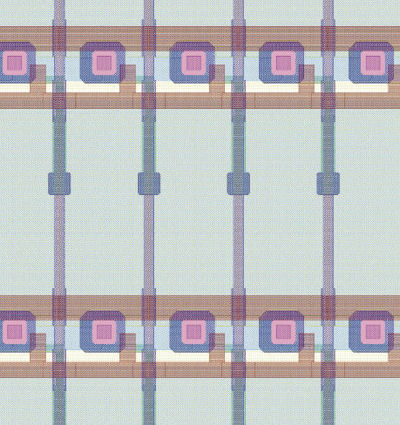 LCD: Structure of LCD pixel as drawn in ECAD software. Images courtesy of Sharp Corp. |
Simulation and modeling software becomes an asset to the intellectual prowess of researchers as they seek the most accurate prediction of the performance and reliability in a very competitive environment. Such is the case for researchers in Sharp Corp.’s R&D laboratories.
According to Valerio Marra, Ph.D., technical marketing manager for COMSOL, Sharp found that COMSOL Multiphysics software was very helpful to its research efforts. As the model grew, Sharp became more familiar with various applications that COMSOL offered in its software.
“You can start with structural mechanics,” says Marra, “and then add heat transfer and other physics in order to accurately represent, thanks to multiphysics, the behavior of your applications. Sharp took advantage of the fact that they can let the model grow accordingly to their simulation needs.”
Once one department learned the software, regardless of the physics used, they were able to train colleagues of other departments in its use and applications. He explains that Sharp was attracted to COMSOL’s “real-world accuracy” simulation approach, meaning they got better and better as they built simulations and models—and at a certain point, they reduced testing significantly and kept optimizing the designs with the software.
Diverse Technology Development
Sharp’s global R&D presence includes laboratories in Japan, which is the global headquarters for R&D, as well as in Oxford, England; Camas, WA; and Shanghai, China. The mission of each laboratory is to develop technology that can be used in Sharp products, and while each lab works on roughly the same research themes—displays, health, energy and lighting—each has its own unique capability to tailor activities to support Sharp’s regional businesses.
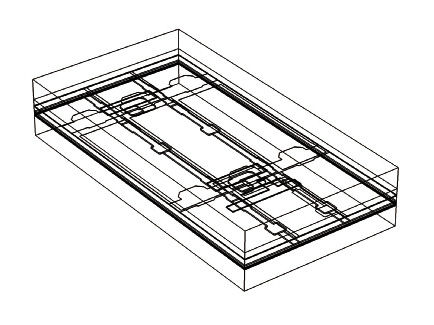 Fig. 1: Imported LCD pixel geometry in COMSOL. |
Sharp Laboratories of Europe (SLE), located in Oxford, has about 100 employees engaged in the R&D of electronic hardware and devices. Chris Brown, Ph.D., is SLE’s research manager for the Health and Medical Devices Group. According to Brown, the multidisciplinary trend is quite compatible with changes in the type of R&D done in the lab.
“Ten years ago, our main research themes were based on improving component technologies—in particular, displays and optoelectronic devices such as semiconductor lasers,” he says. “Activities tended to be driven by depth of knowledge in just one technical specialty, such as optics or electronic circuit design. More recently, though, there has been a shift in focus to systems or products as a whole, such as health systems and energy systems. By their nature, these activities are broader, and the research is driven by understanding how all the parts fit together,”
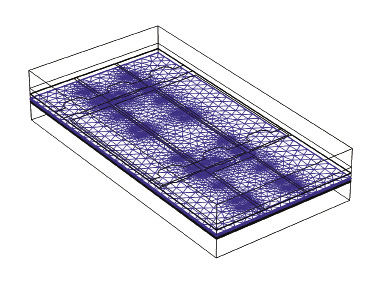 Fig. 2: COMSOL mesh of thin-film high aspect ratio structures. |
SLE uses COMSOL Multiphysics in a number of projects across the lab, for purposes ranging from early-stage research to product development in areas such as light-emitting diode (LED) devices, displays, labs-on-a-chip, and energy systems.
LED and LCD Development
SLE’s use of COMSOL has grown over the last five years, having begun in LED research and expanded to other themes by way of internal recommendations. SLE supports Sharp’s LED business by providing technical analysis and design modifications to improve the performance of LED devices.
One example is optimization of LED electrode designs for improved wall-plug efficiency. A major issue with LED devices is that high operating temperatures can cause a reduction in efficiency in the conversion of electricity to light. The relationship between optical efficiency and temperature in an LED is not linear; any hot spots in the LED chip will disproportionately reduce the efficiency of the entire device.
Sharp’s goal was to create a uniform temperature distribution. This is accomplished by designing the LED’s electrodes so that no hot spots appeared. The resulting uniform temperature distribution also tends to maximize heat dissipation from the LED and lower average temperature.
COMSOL software also helps support Sharp’s displays business. Sharp’s objective is to improve image quality while reducing liquid-crystal display (LCD) power consumption in Sharp products, such as smartphones and TVs. A detailed understanding of the electrical and optical performance of the LCD displays—particularly the electrical characteristics of the LCD pixels—goes a long way toward achieving these goals.
Overall, Sharp’s design and simulation environment for electronic circuit design uses the AC/DC Module found in the COMSOL product suite to extract the parasitic resistances and capacitances of the electrical wiring inside the LCD. Specifically, it capitalizes on the meshing capabilities available in COMSOL Multiphysics to achieve the desired accuracy.
Healthcare Product Development
In the healthcare market, Sharp sought to develop palm-sized diagnostic tools for doctors, nurses and other healthcare professionals to allow blood testing in a matter of minutes, compared with the hours or days it ordinarily takes. Sharp used COMSOL Multiphysics to investigate the interactions between the fluid layer and the electronics.
“We have modeled fluid flow at the input ports of the array, enabling us to design fluid-input structures to get the droplets onto the array in the right place with minimum fluid-input volumes,” says Brown. “This modeling ability gives us a more accurate starting point for experimental work, hence reducing the number of design iterations required, which in turn helps us to reduce R&D prototyping time and cost compared with simple hand calculations.”
The software also allowed them to model interactions between the droplets or particles in the fluid, and the electronic sensors in the array. “In this case, we were interested in investigating impedance changes as droplets or particles in the fluid pass between a pair of electrodes,” Brown says. “The simulation output is a range of likely impedance values, and this can be used as the basis of a specification for designing sensor circuits to detect the presence of the droplets or particles.”
Compatibility and Versatility
COMSOL is compatible with other software tools that Sharp uses, such as CAD programs, Brown notes. The versatility of the software fit nicely in its portfolio, strengthening its overall toolkit for cutting edge research.
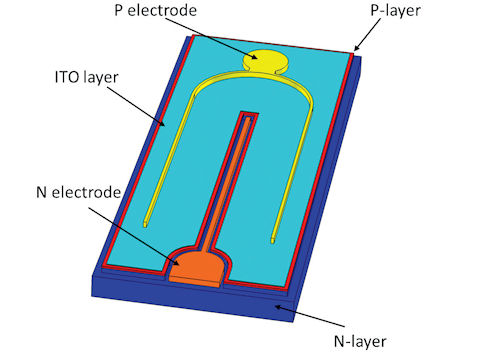 Fig. 3: Structure of an LED chip. |
According to Brown, Sharp attempted the use of parasitic extraction tools from several traditional ECAD software packages, but none were able to successfully cope with the large aspect ratio of the thin-film, large-area structures used in LCDs. For Sharp, the COMSOL software provided the first opportunity to enable versatility and degree of control over the meshing procedure. Ultimately, it allowed them to thoroughly explore such structures.
Brown also says the software’s ECAD Import Module lets researchers transfer layout designs from ECAD software quickly and without error—enabling them to explore the effects of design modifications to a degree not possible otherwise. That’s because the only alternative is to hand-calculate the capacitances between wires using simple linear design equations. The shape of the wiring in the LCD makes this quite complicated, however. In the past, SLE’s researchers made a number of simplifications when using this method. “Hand calculations of capacitance are correct to a first order, but aren’t really of any use when trying to optimize or improve designs,” Brown says.
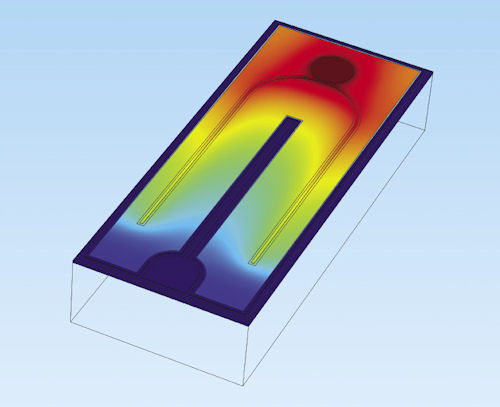 Fig. 4: COMSOL simulation output of an LED structure showing surface electric potential. |
Cross-pollination and Knowledge Transfer
The software’s versatility was key for Sharp, as they used their models and simulations in multiple applications across their R&D efforts. The key advantage of this “cross-pollination” is that a technical solution can be transferred from one application or market area to another, developing solutions that would be otherwise hard to find.
For example, Sharp used COMSOL for its development of new energy storage systems and sustainable heating and cooling. An important R&D target is to optimize the performance of heat exchanger components so as to achieve high heat-transfer efficiency and minimize system size and weight. This work has involved both the optimization of existing heat exchange components and the design of new ones.
“We have simulated the fluid dynamics of cooling fluids in air-conditioning systems and achieved an efficiency improvement of 30 percent with a new system,” Brown reports. “We use COMSOL because this is inherently a multiphysics problem, given the need to link the gas and liquid flows in the system to thermal transfer in the solid components.”
Besides providing technical support for existing products, SLE is also engaged in creating business opportunities for Sharp to enter new markets. Specifically, in the health care arena, SLE led to the development of so-called lab-on-a-chip systems. This demonstrated how COMSOL’s value to Sharp in one application gave way to similar value in another: Sharp was able to leverage manufacturing expertise with the thin-film transistors traditionally used in the LCD market.
For Sharp, COMSOL software parallels the same rigorous approach it uses in R&D explorations. Given the diverse range of projects for which COMSOL Multiphysics is used, each research group has its own license and add-on products. A member of the research staff in each group is responsible for the maintenance of that group’s license.
Ten research staff members across the lab are now trained in its use. Projects and teams are structured to enable flexibility for several researchers across the lab to use the software simultaneously. As team usage of COMSOL grew, they began to dedicate a stand-alone workstation within each group just for COMSOL.
“The multidisciplinary nature of our research activities at SLE will continue in the future,” Brown says. “As such, we expect COMSOL Multiphysics to continue to play an important role, both as a research tool and as a product development tool.”
Jim Romeo is a freelance writer based in Chesapeake, VA. Send e-mail about this article to [email protected].
More Info
Subscribe to our FREE magazine, FREE email newsletters or both!
Latest News
About the Author
Jim Romeo is a freelance writer based in Chesapeake, VA. Send e-mail about this article to [email protected].
Follow DE





